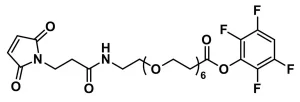MAL-dPEG®24-acid, product number QBD-10315, is a crosslinker that joins sulfhydryl groups to free amines through a single molecular weight polyethylene glycol (PEG) chain of discrete length. The maleimidopropyl moiety reacts with sulfhydryl groups via a Michael addition reaction. The propionic acid terminus of the molecule reacts directly with free amines using EDC or another carbodiimide to form amide bonds. Alternatively, activation of the propionic acid group with N-hydroxysuccinimide (NHS), 2,3,5,6-tetrafluorophenol (TFP), or some other acylating agent permits amide bond formation under mild, controlled conditions.
Chemical couplings between free amines and free thiols are among the most popular, most useful crosslinking reactions in bioconjugate chemistry. These syntheses require heterobifunctional reagents that bridge the two groups. While traditional crosslinkers are hydrophobic molecules, Vector Laboratories’ crosslinking products are water-soluble, amphiphilic, single molecular weight PEG compounds with discrete chain lengths, hence the dPEG® tradename under which we sell them. Almost inevitably, the conjugation of conventional hydrophobic crosslinking reagents to biomolecules triggers problems such as aggregation and precipitation of the conjugates. Conversely, these problems do not occur with our water-soluble, non-immunogenic dPEG® crosslinkers.
The reaction of the maleimide end of MAL-dPEG®24-acid with a sulfhydryl proceeds optimally at pH 6.5 – 7.5. Use the lowest reasonable pH within this range. Above pH 7.5, free amines compete with free thiols at the maleimide reaction site, which can cause confusing results. Moreover, at higher pH values, the maleimide ring may open to form unreactive maleamic acid.
After the maleimide end of the molecule reacts with a sulfhydryl, the terminal propionic acid group may be left unreacted for charge modification or the conjugate or activated with an acylating agent such as NHS or TFP. The active ester then reacts with free amines to complete the crosslink.
| Unit Size | 100 mg, 1000 mg |
|---|---|
| Molecular Weight | 1297.47; single compound |
| Chemical formula | C₅₈H₁₀₈N₂O₂₉ |
| CAS | 871133-36-7 |
| Purity | > 98% |
| Spacers | dPEG® Spacer is 82 atoms and 95.2 Å |
| Shipping | Ambient |
| Typical solubility properties (for additional information contact Customer Support) | Methylene chloride, DMAC or DMSO or waterMethylene chloride, Acetonitrile, DMAC or DMSO or water. |
| Storage and handling | -20°C; Always let come to room temperature before opening; be careful to limit exposure to moisture and restore under an inert atmosphere; stock solutions can be prepared with dry solvent and kept for several days (freeze when not in use). dPEG® pegylation compounds are generally hygroscopic and should be treated as such. This will be less noticeable with liquids, but the solids will become tacky and difficult to manipulate, if care is not taken to minimize air exposure. |
Greg T. Hermanson, Bioconjugate Techniques, 2nd Edition, Elsevier Inc., Burlington, MA 01803, April, 2008 (ISBN-13: 978-0-12-370501-3; ISBN-10: 0-12-370501-0); See pp. 276-335 for general description and use of heterobifunctional crosslinkers, and the specific sample protocol for SMCC or sulfo-SMCC on pp. 283-286.
Greg T. Hermanson, Bioconjugate Techniques, 3rd Edition, Elsevier, Waltham, MA 02451, 2013, ISBN 978-0-12-382239-0; See Chapter 18, Discrete PEG Reagents, pp. 787-821, for a full overview of the dPEG® products.
Applicable patents and legal notices are available at legal notices.




Stay in the Loop. Join Our Online Community
Products
Ordering
About Us
Application
Resources

©Vector Laboratories, Inc. 2025 All Rights Reserved.
To provide the best experiences, we use technologies like cookies to store and/or access device information. Consenting to these technologies will allow us to process data such as browsing behavior or unique IDs on this site. Not consenting or withdrawing consent, may adversely affect certain features and functions. Privacy Statement
How do I Request a Quote?
To request a quote for products: